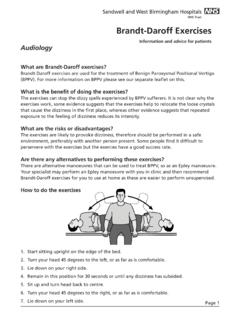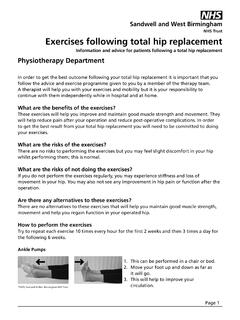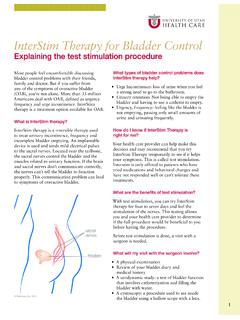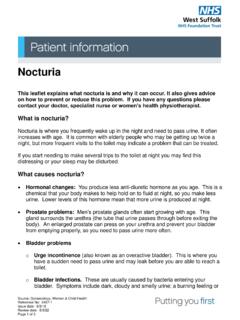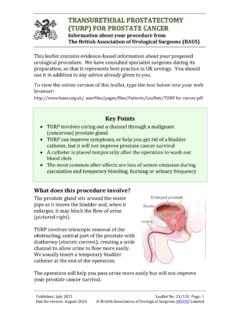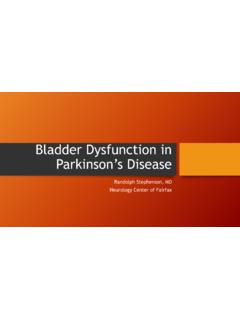Transcription of Bladder Retraining
1 Information and advice for patients Sandwell Community Continence ServiceBladder RetrainingPage 1 What is Bladder Retraining ? Bladder Retraining is a treatment for an overactive Bladder ; where people experience an urgent desire to pass urine and may need to go frequently. Bladder Retraining is a therapy to help people learn to hold on to more urine in their Bladder , so that they need fewer visits to the toilet. It is a 12 week programme and your progress may be monitored by a health professional. How does the Bladder work?The Bladder is a muscular sac that stores urine. As it fills it sends message via the nerves to the brain, the brain responds and send messages to the sphincter (the valve at the base of the Bladder ) to stay closed until a toilet is available.
2 The Bladder should: hold 200mls-500mls (1 -1 pint) empty 4-7 times every 24 hours (including once at night) pass about 1500mls (3 pints) in 24 hoursWhat are the benefits of Bladder Retraining ?With your dedication Bladder Retraining can help to: Correct poor habits such as going to the toilet just in case Reduce and control the urgent desire to pass urine Increase the time between visiting the toilet Reduce accidents wetting yourself Increasing the amount of urine passed each timeWhat are the risks of Bladder Retraining ?The risk of Bladder Retraining is that when you first start trying to retrain your Bladder you may experience more urinary accidents . There is also a risk that Bladder Retraining may not be effective.
3 This is more likely if you are not dedicated to the programme so your nurse will give you encouragement, advice and support to help you as it is not always are the risks of not doing Bladder Retraining ?It you decide to not perform Bladder Retraining , or are not dedicated in sticking to it, your symptoms will not and advice for patients Sandwell Community Continence ServiceBladder RetrainingAre there any alternatives? Bladder Retraining is the first line of treatment for an overactive Bladder . If it is not effective then medication may be recommended in conjunction with Bladder training. Your doctor/nurse will discuss this with you if it is appropriate. How to retrain your bladderFor 2-3 days Go to the toilet as you normally would and keep a record of the following information to identify the extent of your problem, this gives a baseline: How much you drink per day What you are drinking and when The time you go to the toilet and how much you pass by using a plastic measuring jug When you are having any leakage of urineAfter 2-3 daysWhen you feel the need to empty your Bladder , try to wait-2-5 minutes before going to the toilet.
4 This will allow your Bladder to stretch a little. Continue to hold on for short periods of time. Over time, your Bladder will stretch and be able to comfortably hold larger amounts of urine without discomfort. As your Bladder gets used to holding more urine, it will need to be emptied less you have an urgent desire to pass urine:1. stop and stay still2. cross your legs3. tighten your pelvic floor by doing a pelvic floor exercise4. think of something else to take your mind off it5. wait until the urge dies away6. walk at a normal pace to the toiletPage 2 Information and advice for patients Sandwell Community Continence ServiceBladder RetrainingOther lifestyle changes that can help Reduce your caffeine intake Caffeine is found in tea, coffee, cola and drinking chocolate and irritates the Bladder .
5 Reduce your alcohol intake - Alcohol causes your body to produce more urine as well as irritating the Bladder . Drink plenty of fluids - If you do not drink enough your urine will become concentrated and this will irritate your Bladder . Drink enough so your urine is pale straw colour. Do not have more than 300mls (1 glass) of cranberry juice a day. Don t hover over the toilet This does not allow the Bladder to empty fully. Sit properly on the toilet. Practice pelvic floor exercises - Pelvic floor muscles help support your Bladder . Poor muscles (often damaged by child birth or after prostate surgery) may result in leakage of urine. Practising pelvic floor muscle exercises regularly help strengthen them.
6 Ask your nurse for advice and a pelvic floor exercises leaflet. If you have regular urine infections or blood in your urine, seek medical detailsIf you have any further questions or concerns please contact your community nurse or the Community Continence Service on:0121 612 3624 Monday Friday, 8am 4pmFor more information about our hospitals and services please see our website:Sandwell and West Birmingham Hospitals NHS 3If you would like to suggest any amendments or improvements to this leaflet please contact the communications department on 0121 507 5420 or email: Date: April 2012 Review Date: April 2014A Teaching Trust of The University of BirminghamIncorporating City, Sandwell and Rowley Regis Hospitals Sandwell and West Birmingham Hospitals NHS TrustInformation and advice for patients Sandwell Community Continence ServiceBladder RetrainingPage 4 Sources used for the information in this leaflet British Medical Journal, Benign Prostatic Hyperplasia , November 2001 British Medical Journal, Benign Prostatic Hyperplasia: treatment in Primary Care , September 2006 National Institute for Clinical Excellence Clinical Guideline Urinary Incontinence: The Management of Urinary Incontinence in Women London: NICE (October 2006)

